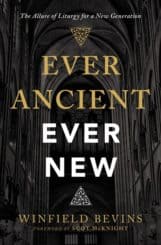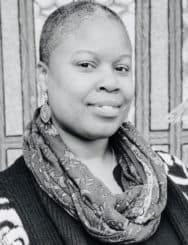
A zealous, albeit flawed, examination of liturgy in contemporary churches.
In his book Ever Ancient, Ever New, Winfield Bevins makes a case for the transformative power of the ancient rituals engaged in by Christians throughout the centuries. Clearly writing to the large swath of evangelicals who have long seen liturgy as suspect, foreign, or no longer relevant, Bevins, with a new convert’s zeal, writes to educate about liturgy. Those liturgical practices that many evangelical Christian communities have let go of, Bevins argues, can revive churches—which are hemorrhaging Millennials—and perhaps even initiate the “convergence of old and new, paving a way forward.”
There is much in this book that resonated with me. As someone who has made my living as a worship leader traveling and connecting with congregations around the country, I have seen firsthand how the synergy of faith and practice based on liturgy can be powerful. And as a member of the band The Many, which is creating new music and liturgically-infused worship experiences for people who seek justice, love, kindness, and are trying to walk humbly with God, I was excited simply that someone was talking about worship at all, and taking worship renewal seriously. In the music that The Many is creating and the worship gatherings we’re leading, part of what we’re trying to do is inspire people to think about worship in new ways—ways that draw from the past but also have eyes open to the headlines and the hurts and the world we are navigating in the present. To do that, we consistently bring together ritual elements of ancient faith traditions with new words and music, and it has proven to be a powerful and transformative experience.
I have seen firsthand how the synergy of faith and practice based on liturgy can be powerful.
I was glad for the education that this book offered about liturgy and for the conversations it could spark for laypeople, both those who are seeking to grow in their faith and those participating in the planning of services. As a worship leader, I welcome the opportunity to dig deeper into what we do when our people come together at 11 am on Sunday mornings (or whenever), and not just assume the way it’s always been in our particular community is the way it should be forever. As leaders, we need to make sure that we are making mindful choices, not just going through the motions.
I resonated with this book in other ways, too. As an artist, I see how worship has too often become one-dimensional. I applaud Bevins’ reminder of how liturgy can engage congregants in all five senses, enabling them to be more fully present, and recognize the mysteries of God and engender a soul-quenching rhythmic and spiritual ancestral connection…thus supporting the holy recognition that all of life is liturgical.
As an African American daughter of a loving, compassionate and community-minded COGIC (Church Of God In Christ) pastor, whose formation is Pentecostal and Charismatic, I appreciated that Bevins explored churches that were bringing together charismatic and liturgical practices, emphasizing the centrality of the Christian faith and the beauty of embracing what has previously been ideologically divided.
I appreciated as well Bevins addressing the “Social Justice vs. Evangelism” construct that many have created in evangelical circles—dividing them into separate categories as if helping those who are marginalized and hurting is not equivalent to saving their souls. Bevins asserts that these are not separate, but meant to work in harmony to lift the whole person into the healing embrace of God. Bevins believes that a “sacramental understanding of the faith fosters this integration.”
However, there is a lot missing in Ever Ancient, Ever New. Throughout the book, to put flesh on his assertion that integrating liturgy into evangelical worship is enriching and meaningful, Bevins takes the reader on a journey to visit various churches that are doing this in a number of different ways. Yet they all seem to be white-centered churches…it was as if no predominantly Black, African, Asian, Pan Asian or Latino congregations or denominations are bringing together the ancient and the new. Which, in my experience, simply isn’t true.
At the very least, Bevins should have made this explicit. He could have stated at the outset of the book that he made the choice to limit his research to only white-centered congregations, acknowledging that he was addressing other white church leaders and choosing to ignore all others. However, as an African American, I longed to hear about how people of color are integrating what was rich and meaningful in our churches growing up with the ancient practices Bevins so admires. And I imagine that predominantly white congregations could learn something from hearing about this as well. Unless Bevins was worried that the mere mention of non-white churches would turn his readers off? The exclusion of black and brown voices is relevant because having only white voices providing definitions, development and the lens through which liturgy and sacrament is engaged is problematic.
…as an African American, I longed to hear about how people of color are integrating what was rich and meaningful in our churches growing up with the ancient practices Bevins so admires.
It was also interesting how careful Bevins was throughout the book, while talking about how much evangelicals can learn from Anglicans, to avoid any mention of Episcopalians—the more theologically liberal and LGBTQ-inclusive branch of the Anglican church in the U.S. I wasn’t sure why Bevins made this choice. But I wonder if it was because he didn’t want non-affirming readers to become frightened away from embracing liturgy because it might lead them down the path to greater acceptance and love for all, including LGBTQIA persons.
Another aspect of the book that kept bothering me as I read was that there was no mention of the classism and racism associated with more liturgical forms of worship—“high church” vs. “low church.” There were no real discussion of how colonization, wealth, theological abuse, predatory behavior, church support of enslaved Africans or the genocide of Native Americans on the North American Continent has directly impacted how we worship and what we value in worship.
There was no acknowledgement of how information and ideas of the church were historically disseminated, or that in some cases the pushback against “high church” traditions was an act of claiming one’s own worth in the eyes of God. As liturgy and sacrament are meant to be healing agents, it would have been beneficial to address the church’s egregious past, and how these historical elements have played a role in the move away from liturgy. This also raised the question as to who sets the definitions for what “liturgy” and “sacraments” are, and whether the definitions are fixed or fluid. Bevins claims that “low church” lacks liturgical elements, which I would argue is only true depending on how you define “liturgical elements” in the first place.
As Bevins tries to convince readers to embrace liturgical elements in worship, he also sometimes, subtly, expresses his distaste for the worship style of megachurches, which is the antithesis of his message that liturgy is a unifying agent that transcends preference and culture. Lifts, smoke machines, and other caricatures were mentioned as lacking merit in the church. In doing so, it seems as if Bevins is falling into the same trap that those who left liturgical traditions to start mega churches sometimes fall into—setting up a “this is better than that,” and disparaging how some folks are choosing to worship God in their fellowship, versus simply informing them that liturgy is a way that they too can delve deeper.
Overall, I appreciate how Bevins highlights the power that liturgy holds to heal and connect in Ever Ancient, Ever New. Yet, I strongly believe that the lens through which a community develops liturgy must be grounded in inclusion and diversity for its liturgical, sacramental power to truly take root.
 Leslie Michele is a classically trained musician steeped in music from the Black American experience. She’s one of the lead singers in the liturgically-grounded, diverse and progressive Christian band, The Many. She’s also performed solo across the globe and is dedicated to creating collaborative performances that help bring about the healing and restoration of communities around the world.
Leslie Michele is a classically trained musician steeped in music from the Black American experience. She’s one of the lead singers in the liturgically-grounded, diverse and progressive Christian band, The Many. She’s also performed solo across the globe and is dedicated to creating collaborative performances that help bring about the healing and restoration of communities around the world.

